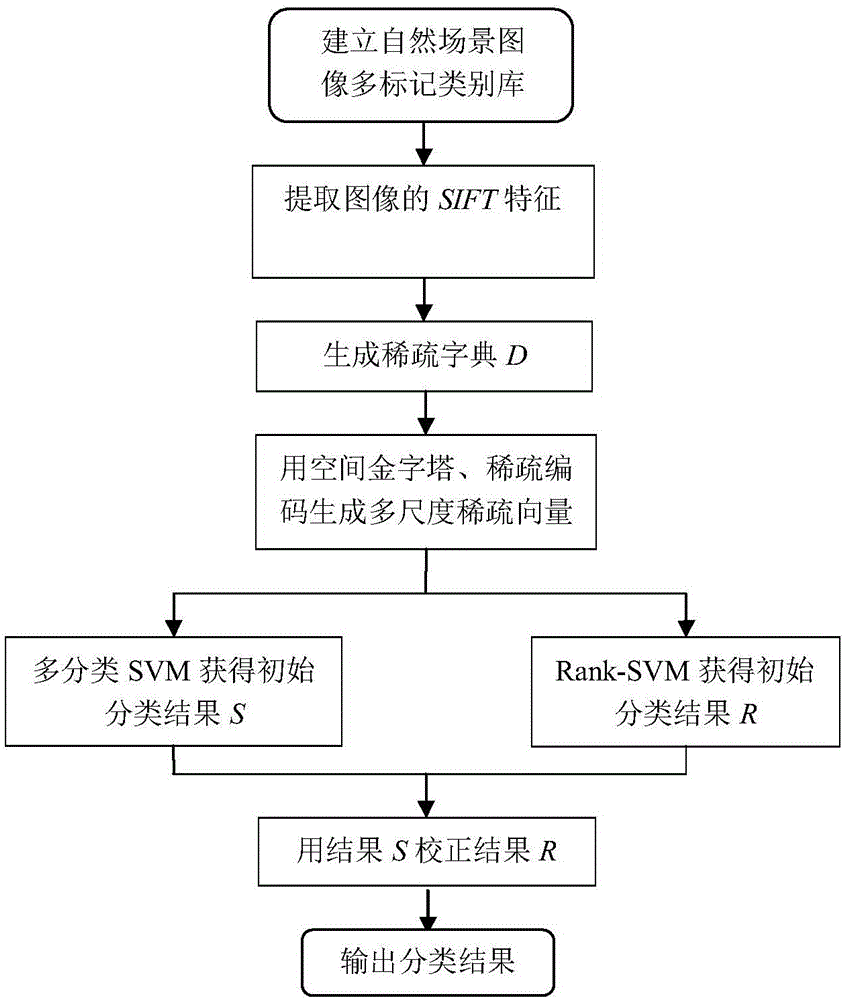Multi-label natural scene classification method based on spatial pyramid and sparse coding
A spatial pyramid and sparse coding technology, applied in the field of multi-label classification of natural scenes based on spatial pyramid sparse coding, can solve the problem that it is difficult to obtain complete and correct classification of images, and achieve high accuracy, good robustness, and robust classification good sex effect
- Summary
- Abstract
- Description
- Claims
- Application Information
AI Technical Summary
Problems solved by technology
Method used
Image
Examples
Embodiment 1
[0030] The invention is a multi-label classification method for natural scenes based on spatial pyramid sparse coding. refer to figure 1 , the specific implementation steps of the present invention are as follows:
[0031] Step 1, establish a multi-label category library for natural scene images, and use images as input data.
[0032] The natural scene image multi-label category library original is used as the image library used in the experiment of the present invention. The image library contains 2000 pieces of natural scene images, and all possible concepts are marked as desert, mountain, ocean, sunset and tree, and each image is manually marked A collection of concept tags. Images with two or more concept labels (such as "ocean+sunset") account for about 22% of the image library, and each image corresponds to an average of 1.24±0.44 concept labels.
[0033] Step 2, for each image in the multi-label category library of natural scene images, extract the scale-invariant SI...
Embodiment 2
[0047] Take k pixels as the step size to uniformly sample, and extract the d-dimensional scale-invariant feature SIFT of the 16×16 pixel image block around each sampling point. In this example, use 6 pixels as the step size to sample uniformly, and extract each sampling point The d-dimensional scale-invariant feature SIFT of the surrounding 16×16 pixel size image block,
[0048] The natural scene multi-label classification method based on spatial pyramid sparse coding is the same as embodiment 1, wherein the d-dimensional scale-invariant feature SIFT of extracting the 16 × 16 pixel size image block around each sampling point described in step 2 is carried out as follows:
[0049] (2.1) Gaussian filtering is performed on an image block with a size of 16×16 pixels, wherein the parameters of the Gaussian filtering are: the mean value is 0, the variance is 1, and the size is 5×5 pixels;
[0050] (2.2) Calculate the gradient modulus and gradient direction of each pixel in the Gauss...
Embodiment 3
[0053] The natural scene multi-label classification method based on spatial pyramid sparse coding is the same as embodiment 1-2, wherein the SIFT feature matrix to all images described in step 3, randomly selects M feature vectors therefrom to form a new feature matrix Y, which is passed through K-singular value decomposition method K-SVD training dictionary D, proceed as follows:
[0054] (3.1) Randomly select M eigenvectors from the SIFT eigenmatrices of all images to form a new eigenmatrix Y, the size of which is 128×M, wherein M generally takes values of 100000, 200000, 1000000, and M=200000 in this embodiment , the invention selects M feature vectors from the feature matrix for dictionary training, which reduces the amount of training calculations.
[0055] (3.2) randomly select the B column eigenvectors in the matrix Y to initialize the dictionary D, the number of atoms of the dictionary B=1024 in the present embodiment, the size of the dictionary D is 128 * 1024, the ...
PUM
 Login to View More
Login to View More Abstract
Description
Claims
Application Information
 Login to View More
Login to View More - R&D
- Intellectual Property
- Life Sciences
- Materials
- Tech Scout
- Unparalleled Data Quality
- Higher Quality Content
- 60% Fewer Hallucinations
Browse by: Latest US Patents, China's latest patents, Technical Efficacy Thesaurus, Application Domain, Technology Topic, Popular Technical Reports.
© 2025 PatSnap. All rights reserved.Legal|Privacy policy|Modern Slavery Act Transparency Statement|Sitemap|About US| Contact US: help@patsnap.com



